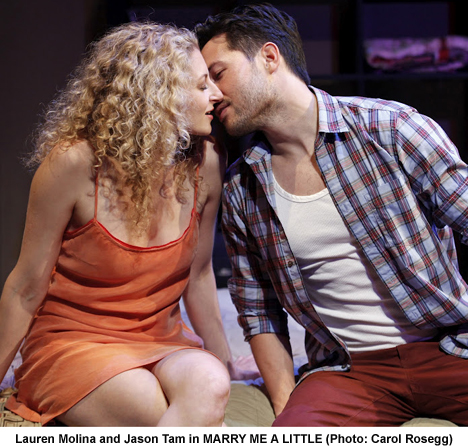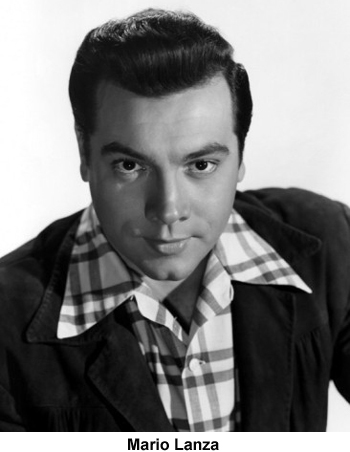
I'm one of those people who look askance at musicals built around pre-existing songs, but many of us who feel that way are happy to give a pass to Marry Me a Little. Originally staged Off-Broadway in 1981, the show was the brainchild of Craig Lucas (then an actor, later a noted playwright) and director Norman René. Their nifty idea was to take a bunch of songs that had been cut from various Stephen Sondheim musicals, add a few other Sondheim songs that were then considered to be obscure for one reason or another, and string them together in such a way as to tell the story of two big-city neighbors separately yearning for love without realizing it might be just one floor away.
The show and its RCA original cast recording gave new life to then little-known Sondheim gems such as "So Many People," "The Girls of Summer," "All Things Bright and Beautiful," "Can That Boy Foxtrot," "There Won't Be Trumpets," "Your Eyes Are Blue," and the title song, which had been cut from Company and only found its way back into that show years later. René died in 1996, but Lucas is still very much with us, and he has been working with director Jonathan Silverstein on the revised version of Marry Me a Little that the Keen Company is presenting at The Clurman Theatre at Theatre Row. Now in previews, the show will open officially on October 2. I recently spoke with Silverstein about the project, and here's what he had to say:
*****************
BROADWAYSTARS: Can you talk a little about the genesis of Marry Me a Little?
JONATHAN SILVERSTEIN: Craig Lucas was in the chorus of Sweeney Todd. He and Norman René approached Sondheim about creating a show using songs that had been cut from his shows, along with some of his lesser-known pieces and a few songs from Saturday Night, which at that time hadn't yet been produced. Sondheim okayed the project, Craig and Norman put the show together, and Craig was in it with Suzanne Henry.
STARS: The concept of the show is that the two characters, a man and a woman, live in the same apartment building...
JONATHAN: Yes, they live upstairs and downstairs from each other. She has just moved into the building, he's been there for awhile, but they don't know each other at all. They're total strangers. The whole thing is staged in one apartment, but you get clues along the way that it's supposed to represent two separate apartments.
STARS: So the characters never interact?
JONATHAN: Well, in the middle of the show, there's a fantasy sequence where they conjure each other as the embodiment of their ideal mate. But other than that, they don't interact at all. I believe there was a production that started with the man and woman getting into an elevator together, but that wasn't part of the original concept.
STARS: What are some of the changes and additions you've made for your production?
JONATHAN: The first big change is that we've set the show in the present day, which of course changes some of the stage business and the props. We've re-ordered some of the songs and added a few others, so the journey is a little different. We've added another fantasy sequence towards the end of the show, and there's a slightly different resolution at the very end. I could give it away, but maybe I shouldn't.
STARS: Please don't! You say you've added a few songs; have any from the original version been cut?
JONATHAN: Yes. "Two Fairy Tales," which used to open the show, has been removed. Now we start with "If You Can Find Me, I'm Here" from Evening Primrose, followed by the title song from Saturday Night. "Pour le Sport" is out. "Uptown/Downtown" has been replaced by "Ah, But Underneath," and we've added "Bring on the Girls" -- all three of those songs were written for Follies -- and "Rainbows," which Sondheim wrote for a proposed film version of Into the Woods. I think "Rainbows" is the least well known song of all of them, and in a way it has determined the different shape of the show that we have now. We've also added instrumental music from various Sondheim shows. And another difference in our production is that the piano player is almost a character in the show.
STARS: Many of the songs that were thought of as rare or obscure when the original production opened are now fairly well known from having been performed in concerts, cabaret shows, and so on.
JONATHAN: Well, some people still don't know them. But of course, the Sondheim fans know everything.
STARS: Talk to me about the casting of Lauren Molina and Jason Tam.
JONATHAN: In a way, the show is an acting piece about two people alone in their apartments on a Saturday night, so we wanted performers who could not only sing well but could really get into the characters' heads. On top of that, I wanted to find interesting personalities that would work well together. Lauren is fascinating, quirky, and funny, while Jason has a real depth of emotion to him -- and once we got them in a room together, the chemistry was just fantastic. One of the things Craig Lucas and I have talked about is that the audience should really want these two characters to get together, and with Lauren and Jason, I think we have that. It was a benefit that Lauren plays the cello; we're taking advantage of that in the show.
STARS: So I've heard. Does Jason dance in the show?
JONATHAN: He dances a little! The show is really a chamber piece. There are no big production numbers, but there is some dancing. Dan Knechtges is our choreographer. One of the challenges of this piece is that you don't want it to feel like a revue. That's part of the reason why she switched some of the songs in and out; we wanted all of them to sound as if they were coming from these two characters. I've been working closely with Craig, and I think he's happy with the changes. I haven't worked directly with Sondheim as much, but he has also been involved, and the openness that both of them have had toward looking at this piece anew has been really inspiring.
 The late, great tenor Mario Lanza is most famous for almost single-handedly popularizing opera for a mass audience of Americans in the 1950s through his glorious singing in a series of big-budget films, not to mention his plethora of recordings. But because Lanza achieved stardom at a time when legit voices were warmly welcome in popular songs and show music, he made his mark in those genres as well. I fondly remember an old LP I used to have that included a thrilling Lanza rendition "Younger than Springtime" from Rodgers and Hammerstein's South Pacific. (I've really got to try to track down that album...)
The late, great tenor Mario Lanza is most famous for almost single-handedly popularizing opera for a mass audience of Americans in the 1950s through his glorious singing in a series of big-budget films, not to mention his plethora of recordings. But because Lanza achieved stardom at a time when legit voices were warmly welcome in popular songs and show music, he made his mark in those genres as well. I fondly remember an old LP I used to have that included a thrilling Lanza rendition "Younger than Springtime" from Rodgers and Hammerstein's South Pacific. (I've really got to try to track down that album...)
 Debra Barsha composed the music for Radiant Baby, one of the best musicals you've probably never heard of. For whatever reasons, the show was not a critical success in its 2003 world premiere production at The Public Theater, despite an impressive pedigree: music by Barsha, lyrics by Ira Gasman, directed by George C. Wolfe, with a cast headed by Daniel Reichard in the central role of Keith Haring. But if you ever get a chance to see it, do not hesitate. (Trust me.)
Debra Barsha composed the music for Radiant Baby, one of the best musicals you've probably never heard of. For whatever reasons, the show was not a critical success in its 2003 world premiere production at The Public Theater, despite an impressive pedigree: music by Barsha, lyrics by Ira Gasman, directed by George C. Wolfe, with a cast headed by Daniel Reichard in the central role of Keith Haring. But if you ever get a chance to see it, do not hesitate. (Trust me.) One might say that Marilyn Maye is having a glorious renaissance, except that there really haven't been any dark ages in this lady's career. Famous as one of Johnny Carson's all-time favorite performers -- she holds the record among singers for appearances on The Tonight Show, at a whopping 76 -- Marilyn has in recent years been working constantly in cabarets, theaters, and concert halls all over the country, including two of New York's top venues, the Metropolitan Room and Feinstein's at Loews Regency.
One might say that Marilyn Maye is having a glorious renaissance, except that there really haven't been any dark ages in this lady's career. Famous as one of Johnny Carson's all-time favorite performers -- she holds the record among singers for appearances on The Tonight Show, at a whopping 76 -- Marilyn has in recent years been working constantly in cabarets, theaters, and concert halls all over the country, including two of New York's top venues, the Metropolitan Room and Feinstein's at Loews Regency. 